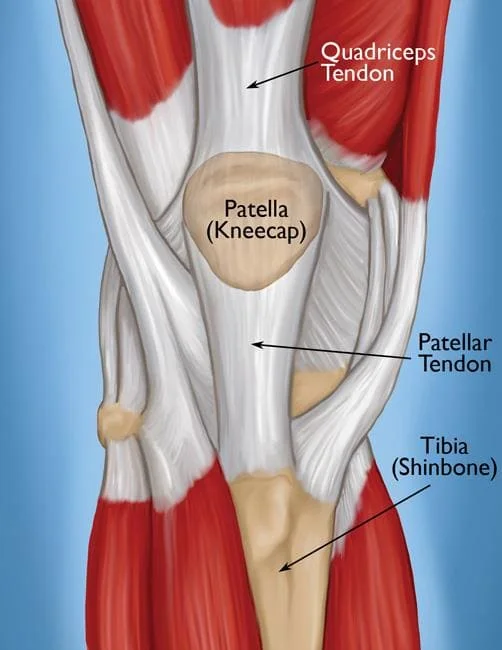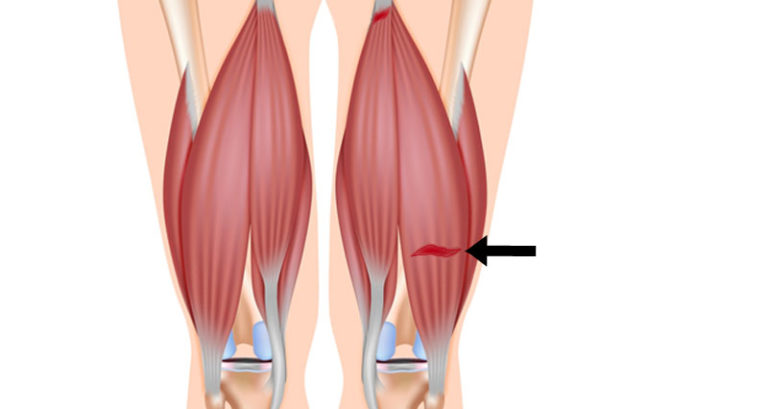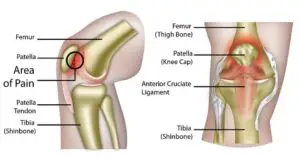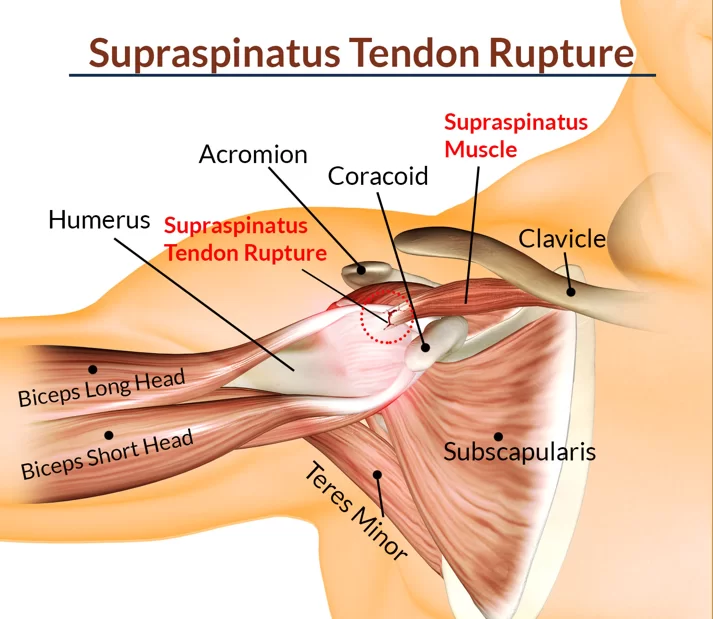Quadriceps Tendon Sprain
What is a Quadriceps Tendon Sprain?
A quadriceps tendon sprain involves the overstretching or tearing of the fibers within the quadriceps tendon, often resulting from sudden, forceful movements or overexertion. This injury can lead to pain, swelling, and a decrease in the affected leg’s range of motion.
Understanding the causes, symptoms, and appropriate management of quadriceps tendon sprains is essential for prompt and effective treatment, minimizing long-term consequences, and facilitating a successful recovery.
Introduction
Straightening your leg is facilitated by the tough quadriceps tendon. This action is made harder by a painful condition known as a quadriceps tendon tear or rupture, which typically results from an impact injury.
The extent of the tear determines how long recovery takes. Surgery and rehabilitation treatment are typically necessary, and the procedure might be extensive.
Anatomy of Quadriceps Tendon
One of the largest muscle groups in the upper front portion of your leg is the quadriceps. They support your ability to leap, run, stand, and maintain balance. The quadriceps tendon connects the four muscles that make up the quadriceps group at their base.
Your quadriceps and bones are connected by this tendon as well. It’s situated directly above your patella or kneecap. Your quadriceps tendon aids in leg straightening.
In the meanwhile, the patellar tendon is located beneath the patella. That joins to the bone in your lower leg called your tibia. Together, these tendons and muscles create powerful, useful leg muscles.
Epidemiology
Ruptures of the whole lower leg extensor mechanism are extremely uncommon, although they have a high morbidity rate and are frequently disabling. The incidence of torn quadriceps tendons is 1.37/100,000, while the incidence of torn patellar tendons is 0.68/100,000. Unilateral extensor mechanism ruptures are the most frequent kind. Men are more likely than women to cry both partially and completely. Quadriceps tendon ruptures are comparatively uncommon and mostly affect people over the age of 40. However, these breaks can occur in almost any age range.
- often affects persons over 40, with males outnumbering females (up to 8:1).
- occurs more than twice as frequently in nondominant limbs
Symptoms and Causes of Quadriceps Tendon Sprain
- Age and several medical comorbidities are positively correlated with quadriceps tendon tears. Historically, men over 40 have been more likely to sustain this injury. This contrasts with patellar tendon rips, which often happen before the age of 40 and are frequently connected to sports-related accidents.
- An unfortunate landing or a high-impact motion can frequently result in a muscle rupture. A landing involves landing with the foot firmly planted on the ground and a heavy weight on the knee in flexion (jump).
- The quadriceps muscle contracts quickly and eccentrically. A force directly applied to the anterior side of the knee (a fall) is the source of another mechanism. After a trip, fall, or knee giving way, patients usually arrive with acute knee pain, edema, and loss of function.
Which of the following tears the tendon in their quadriceps?
A torn quadriceps tendon may happen to anyone. Those over 40 who were assigned male at birth (AMAB) are most commonly affected.
This kind of injury is more common in physically active persons between 50 and 60 and athletes. You run a higher risk if you participate in some connected sports and activities, such as:
- Jumping.
- Kicking.
- Running.
- Stretching.
To what extent do quadriceps tendon tears occur?
Tears in the quadriceps tendon are uncommon. About 1 in 100,000 persons experience them.
Tears in the quadriceps tendon usually happen when your knee bends beneath a large weight. The stress is too great for your tendon, for example, if you land awkwardly after leaping or twist your knee.
When you strive to avoid falling or when you fall, you run the risk of tearing your quadriceps tendon. A tear can also result from direct stress to the front of the knee, such as a cut or trauma.
What more variables might raise your chance of tearing a quadriceps tendon?
People who have weakness in their joints or tendons may get rips in their quadriceps tendon. Underlying health conditions, such as could potentially be the cause of this:
- Chronic kidney (renal) disease (CKD).
- Diabetes mellitus.
- Gout.
- Leukemia.
- Obesity.
- Rheumatoid arthritis (RA).
- Secondary hyperparathyroidism.
- Systemic lupus erythematosus (SLE).
- Tendinitis.
Additional risk characteristics associated with muscle and tendon weakness include:
- Corticosteroids and fluoroquinolones (special antibiotics), knee surgery and immobilization, and previous knee injury can cause knee problems.
Injury
A quadriceps tear occurs due to a heavy load on the leg with the foot planted and the knee partially bent. There is no room for obscurity here. An awkward landing from a jump while playing basketball is one of the main reasons that can cause this injury. The force of the landing can be too much for the tendon, leading to a tear.
In addition to this, tears can also be caused by falls, direct force to the front of the knee, and lacerations (cuts). Consider a scenario where you are playing basketball and you land awkwardly after a jump. This landing exerts excessive force on the tendon which results in its tearing.
Tendon Weakness
If the quadriceps tendon is weakened, it is more susceptible to tearing. There can be various reasons leading to the weakening of the tendon.
Quadriceps tendinitis, which is the inflammation of the quadriceps tendon, can weaken the tendon and even cause minor tears. Quadriceps tendinitis is commonly observed in people who participate in sports that involve running and jumping.
Tendons can also be weakened by chronic diseases that disturb blood supply. Chronic conditions that can cause tendon weakness include:
- Chronic renal (kidney) failure
- Other conditions associated with renal dialysis
- Hyperparathyroidism
- Gout
- Leukemia
- Rheumatoid arthritis
- Systemic lupus erythematosus (SLE)
- Diabetes mellitus
- Infection
- Metabolic disease
The use of corticosteroids has been shown to cause greater weakness in muscles and tendons.
Quadriceps tendon tears have been linked to the use of fluoroquinolones, a specific type of antibiotic. Prolonged immobilization can lead to weakened muscles and tendons in the knee area due to a loss of strength and flexibility.
If a quadriceps tendon gets torn, it is common to experience a sensation of tearing or popping. Subsequently, pain and swelling usually occur, and you might find it difficult to straighten your knee. Other symptoms that may appear include an indentation at the top of your kneecap where the tendon was torn.
- Bruising
- Tenderness
- Cramping
If the tendon is torn, your kneecap might droop or sag.
You may experience difficulty while walking as the knee might buckle or give way.
When a quadriceps tendon tears, there may be a popping or tearing sensation. This is usually followed by pain and swelling, and you might not be able to straighten your knee.
Other symptoms include:
A hollow at the top of the kneecap where the tendon got torn.
Diagnosis and Tests
A physical examination is the usual method for diagnosing a quadriceps tendon rupture. During the exam, a healthcare provider may assess your ability to straighten your knee.
Additional tests may be recommended to determine the exact location and extent of the injury. These tests may include:
- X-rays can help identify a torn quadriceps tendon by showing the movement of the kneecap out of its normal position. Complete tears can often be detected with X-rays alone. On a side view X-ray, the kneecap appears out of place due to a torn quadriceps tendon, with the remaining patellar tendon pulling it toward the floor.
- Magnetic resonance imaging (MRI), provides better images of soft tissues such as the quadriceps tendon than X-rays. An MRI may not be required after this injury, given the usually informative physical examination. However, it can show the extent and location of the tear if this information is necessary. Sometimes, an MRI is necessary to rule out a different injury that has similar symptoms or to distinguish a partial tear from a complete tear.
Treatment of Quadriceps Tendon Sprain
The severity of the tear will determine the available treatment options, which may either be surgical or nonsurgical. Your doctor will consider factors such as the type and size of the tear, your age, and your activity level when planning your treatment.
In cases where the quadriceps tendon tear is minor, nonsurgical treatment is usually the first option and often proves effective. This may involve wearing a brace and working with a physical therapist to safely strengthen the quadriceps muscles.
- Immobilization: Immobilization may be necessary for three to six weeks, and your doctor may recommend a knee immobilizer or brace to keep your leg straight while the torn tendon heals. You may also need to use crutches to avoid putting too much weight on your leg.
- Physical therapy: Physical therapy can begin once the initial pain and swelling subsides. Your therapist will gradually add exercises to help you regain strength and range of motion. As the tear heals and your muscles become stronger, your brace may be removed, and you will be given exercises to do at home. Before returning to sports, always consult your doctor to ensure that it is safe.
- If the quadriceps tendon tear is severe, surgery will be necessary to repair the torn tendon and reattach it to the kneecap. Early surgery after an injury leads to better outcomes. Early repair also prevents the tendon from scarring and tightening when in a shortened position.
- Tendon repair surgery: Tendon repair surgery is sometimes performed on an outpatient basis, but it more commonly takes place in a hospital, and an overnight stay may be required. Regional (spinal) anesthesia or general anesthesia may be used during the surgery. Regional anesthesia numbs the lower body, while general anesthesia puts you to sleep.
- Rehabilitation: The physical therapy and exercise rehabilitation program your doctor prescribes will be tailored to your specific tear type, surgical repair type, and any other existing medical conditions you may have. You will need medication for pain management and ice to help with recovery after the surgery. After about two weeks of surgery, the surgeon will remove any sutures or staples that have been inserted. While complete recovery takes at least four months, most repairs are almost completely healed within six months. It may take even longer to achieve strength training and range of motion goals completely.
Possible Complications
Procedural complications are infrequent, though all procedures carry some amount of risk. Potential complications, such as those listed below, will be discussed by your physician during the review:
- Weakness
- The joint experiences stiffness or loss of motion.
- Bleeding
- Infection
- The normal movement of tendons can be restrained by the development of scar tissue.
- Re-rupture of the injury
If you are 60 years or older, your risk of complications may increase. Additionally, other factors can contribute to an increased risk of complications.
- Smoking
- Obesity
- Diabetes
- Poor overall health
- Use of certain medications
Risk factors
Quadriceps tendon tears are a common problem that can be caused by a range of factors.
Inflammation of the tendon can lead to weakening and even minor strains.
Additionally, a poor blood supply to the tendon due to diseases can also contribute to the weakening of the tendon. It is important to understand these potential causes to take preventative measures and ensure proper treatment in the event of an injury. Most quadriceps tendon tears happen because the tendon is weakened.
Chronic diseases:
The weakening of the fibro-cartilaginous junction between the tendon and bone tissue occurs due to bone resorption caused by secondary hyperparathyroidism. Connective tissue elastosis, resulting from chronic renal failure, suggests a weakening of the tendon.
Tendon strength is negatively affected by various conditions including systemic lupus erythematosus (SLE), gout, leukemia, rheumatoid arthritis, diabetes mellitus, obesity, infections, and metabolic diseases.
Muscle tendon degeneration is also caused by drug abuse.
Corticosteroid usage has been associated with an increase in muscle and tendon weakness.
Tendon ruptures are linked to fluoroquinolones, a special type of antibiotic.
The chance of tendon degeneration increases due to other factors such as knee surgery and immobilization as they decrease the strength and flexibility of the muscle and tendon.
When should an individual visit their physician?
If your recovery from quadriceps tendon tear surgery is not going as planned or if you experience any complications, it is important to contact your doctor. These complications may include:
- Fever and chills, which could be signs of an infection.
- Redness, swelling, excessive bleeding, discharge from the incision site, or increasing pain.
- Pain that cannot be controlled by the medication that was prescribed to you.
- A broken brace or a brace that is not functioning properly.
- Numbness, tingling, discoloration, or coldness in the skin below the cast.
- Any symptoms you may have that are either new or getting worse.
Conclusion
An injury known as a quadriceps tendon tear happens when the tendon in the front of your thigh partially or completely tears due to an abrupt and forceful impact on your thigh. If you experience this injury, there are available surgical and non-surgical treatment options to aid in the healing of your quadriceps tendon.
Even though quadriceps tendon tears are rare, they are serious injuries that mostly occur among those in their middle age who participate in running or jumping sports.
FAQs
How long does it take for a quadricep tendon sprain to heal?
You may experience swelling or slight bruising, as well as discomfort when walking or bending your knee. It typically takes 4-6 weeks to fully recover, and rehabilitation is necessary to restore complete functionality.
What does a quadricep tendon sprain feel like?
If you have experienced a quadriceps strain, you may feel tenderness and pain which can worsen when you move your injured leg. Additionally, you may notice swelling and bruising in your thigh. In some cases, a severe strain can limit your ability to move your leg normally. However, a minor strain can typically be treated with rest and other appropriate measures, leading to a full recovery.
Can you walk with a torn quadricep tendon?
Experiencing pain or difficulty in walking and other daily activities are common symptoms of small tears in this tendon. A complete tear of the quadriceps tendon can be a debilitating injury that typically necessitates surgery. After the surgery, physical therapy is usually required to restore full knee motion and function.
Can a quadriceps tendon heal itself?
Sometimes minor tears can be treated without surgery, but immobilization of the quadriceps and physical therapy will likely be suggested. If the tear is complete, surgery will almost always be necessary, and the sooner it’s done, the greater the chances of a full recovery.
What exercises are good for quad tendon repair?
For 6-8 weeks, it is recommended to perform mini-squats, short arc quads, light leg press partial range, as well as core exercises for strengthening. During the next 8-12 weeks, it is advised to progress to squatting exercises with bodyweight squats leading up to weighted squats and also to perform long arc quad exercises with no resistance. For the final 12-16 weeks, it is suggested to perform more advanced exercises, such as single-leg squats, barbell squats, and deadlifts, to further enhance strength and endurance.
References
- Quadriceps Tendon Tear | Florida Orthopaedic Institute. Florida Orthopaedic Institute. https://www.floridaortho.com/specialties/knee-leg/quadriceps-tendon-tear/
- Quadriceps Tendon Tears: Causes, Diagnosis and Treatment Options. https://lgphysicians.com/about/newsroom/quadriceps-tendon-tears-causes-diagnosis-and-treatment-options
- Quadriceps Tendon Tear. Cleveland Clinic.https://my.clevelandclinic.org/health/diseases/quadriceps-tendon-tear
- Quadricep Tear or Strain | Orthopedic & Knee | https://www.bonsecours.com/health-care-services/orthopedics-sports-medicine/knee/conditions/quadricep-tear-or-strain
- What to Know About a Quadriceps Tendon Tear. WebMD. https://www.webmd.com/pain-management/what-to-know-quadriceps-tendon-tear
- Quadriceps Tendon Tear. (n.d.). Physiopedia. https://www.physio-pedia.com/Quadriceps_Tendon_Tear
- Quadriceps Tendon Tear – OrthoInfo – https://orthoinfo.aaos.org/en/diseases–conditions/quadriceps-tendon-tear/








One Comment